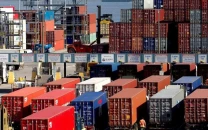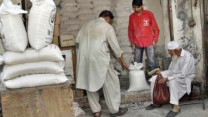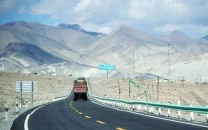FY17: With start of new projects, oil production edges up 3%
Country produced 88,189 bpd, still lower than initial average of 95,000 bpd

A temporary shutdown of some major fields also affected production as at the start of 2017 oil production averaged 95,000 bpd initially. PHOTO: REUTERS
Major listed exploration and production companies, including Oil and Gas Development Company (OGDC), Pakistan Petroleum Limited (PPL) and Pakistan Oilfields Limited (POL), had a comparatively impressive performance, registering growth in the range of 9% to 11%.
“While OGDC’s oil production grew 9% year-on-year, POL and PPL posted a robust increase of 11% each,” Topline Securities’ analyst Nabeel Khursheed said in a report to clients.
OGDC’s share price rose 0.32%, or Rs0.49, to close at Rs150.13 with a volume of 451,800 shares at the Pakistan Stock Exchange on Monday.
PPL’s share price strengthened 0.52%, or Rs0.91, at Rs175.69 with a volume of 147,200 shares.
POL’s stock gained 0.85%, or Rs3.91, to end the day at Rs458.10 with 82,900 shares changing hands at the stock exchange.
The brokerage house said the improvement in oil production followed an 11% drop in output in the preceding fiscal year.
However, the FY17 “production was lower than our expectation of 95,000 barrels per day, mainly due to delay in some key projects and higher-than-anticipated natural depletion of existing fields.”
A temporary shutdown of some major fields also affected production as at the start of 2017 oil production averaged 95,000 bpd initially, he said. During June 2017, oil production rose 10% year-on-year to about 91,000 bpd. On a month-on-month basis, it was up 11% because of a low base effect.
“To recall, Nashpa field (which accounts for 26% of Pakistan’s total oil production) experienced a brief shutdown in May 2017,” he said.
Flat gas production
Pakistan’s gas production remained, however, flat in FY17 primarily because of absence of major additional flows and depletion of existing fields.
While OGDC’s gas production numbers failed to cause any excitement, PPL and POL recorded 5% growth each.
“Additional flow from Kandhkot field (which constitutes 22% of PPL’s gas output) primarily supported growth in PPL’s gas production while new addition from Mardankhel field (8% of POL’s gas production) lifted POL’s gas flow,” Khursheed said.
Pakistan’s overall hydrocarbon production stood at 761,000 barrels of oil equivalent per day (boepd) in FY17, almost flat year-on-year.
OGDC, PPL and POL registered 1%, 7% and 6% growth respectively in their hydrocarbon production levels.
In FY17, the price of Arab light crude - a benchmark for exploration and production companies - averaged $48.4 per barrel in line with the brokerage house’s forecast which was based on projections of the Energy Information Administration (EIA).
“Taking cue from EIA’s recent report on oil outlook, we expect the Arab light crude price to average $49, $52 and $57 in FY18, FY19 and FY20, respectively,” the analyst said.
Published in The Express Tribune, July 25th, 2017.
Like Business on Facebook, follow @TribuneBiz on Twitter to stay informed and join in the conversation.



















COMMENTS
Comments are moderated and generally will be posted if they are on-topic and not abusive.
For more information, please see our Comments FAQ